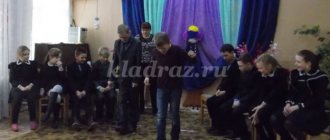Sports festival at summer camp
Category: Vacations
Tags: Children,Summer holidays,Holidays and leisure
Outdoor games for children from 6 to 12 years old
Sports activities must be included in the shift program at a children's camp. Fun and dynamic games promote healthy and active recreation and physical development of children.
Rod A fun children's game with a jump rope to test endurance and coordination of movements. It can be played by a very large group (10-20 people). Before the game starts, a driver is selected. All the guys stand in a circle, and the driver stands in the center of the circle with a skipping rope in his hands. He begins to rotate the rope so that it slides along the floor, making circle after circle under the feet of the players. The players jump, trying to prevent it from hitting any of them. A player is considered caught if the rope touches him no higher than his ankle. Players should not approach the driver while jumping. The one who touches the rope stands in the middle and begins to rotate the rope, and the former driver takes his place. Notes. 1. As an additional item, you will need a jump rope (you can also use a rope with a bag of sand tied to the end). 2. You can use another version of this game, which will be competitive in nature - the player who touches the rope is eliminated from the game. The winners are the last 2-3 players who did not touch the ropes. Waves in a circle Waves in a circle is a dynamic, fun game. Good for developing reactions and utilizing excess energy in children. The chairs are placed close to each other in a circle. There are as many chairs as there are players. One of the players (the driver) stands in the center of the circle. The remaining players sit on chairs, and one of the chairs remains free. The driver must have time to sit on an empty chair while others move back and forth, disturbing him. When the driver manages to take a place on the chair, the player who did not have time to interfere with him becomes the new driver. The driver can give commands to the participants “Right” (players must move clockwise one space), “Left” (players must move counterclockwise one space) or the command “Chaos”. With the command “Chaos”, the participants must quickly change places, the leader tries to sit on any free chair. The player who occupied the chair that was free before the “Chaos” team becomes the driver. Note. You can make the game more difficult by turning the chairs outward. At the same time, the driver runs outside the circle and is prohibited from the “Chaos” command.
Liberators Liberators is a dynamic game that develops hearing, attentiveness, coordination and reaction in the leading player and dexterity and reaction in the other players. Form a circle of chairs to limit the movement of players. A participant with his hands and feet tied (prisoner) sits in the center of a circle formed from chairs. Next to him is a blindfolded player (guard). The remaining participants in the game (liberators) try to free the prisoner, that is, they try to untie him. The guard must place. By touching any participant, he takes him out of the game, he must go beyond the circle of chairs. The player who manages to free the prisoner without being caught becomes the guard himself the next time.
The Most Flexible The Most Flexible is an active, fun game for a large group of children. The game helps develop flexibility and coordination of movements. The leader pulls a jump rope (or rope) between two posts or trees at the height of the players’ chests. Players must pass under it, bending backwards, without touching the rope. Each time players pass under the rope, it drops 30 centimeters lower. The participant who touches the rope is eliminated from the game. The last one left wins.
Invisible Cap Invisible Cap is a dynamic ball game. The players stand in a circle, looking at the back of each other's heads, and the ball lies in the middle of this circle. After this, the players begin to pass the hat (the player who has the hat passes it to the player in front). So they pass the hat around in a circle until someone decides that it’s time for his neighbor to become invisible - the player with the hat, unexpectedly for the one standing in front, puts a hat on his head with the words “Beware of the invisible!” After which all the players scatter, and the invisible person must run to the ball, grab it and shout “Stop, don’t move!” After this, all players stop, and the invisible woman tries to hit any player with the ball from her place. If the invisible man hits any player, then he throws his hat and runs away, and the player (who was hit by the invisible man) himself becomes invisible (i.e. runs to the ball, puts on his hat and tries to hit another player, and so on). If the invisible one (it doesn’t matter which one) misses, then the game starts again. Note. When standing in a circle, you are not allowed to turn back.
Color A simple outdoor game for children 6-12 years old. 10 or more people can take part in it. Before the game, you need to choose a driver and agree on the boundaries of the playing area, beyond which you cannot run. The players stand in a line, and the driver closes his eyes and stands with his back to the players, 5-6 meters away from them. Then he loudly names any color (for example, red) and quickly turns to the players. Those players who have clothing (or an element of it) of the named color, or some other item, grab these items. And those who don’t have them run away. The driver’s task is to catch up and touch the runner (i.e., to grease). After which the successful player becomes the driver and everything is repeated again. During the game you must not run outside the established area. You need to grab the named color so that the driver can see it. Colors should not be repeated during the game.
Hunting Hunting is an active game for developing dexterity and coordination of movements for children over six years old. Suitable for large groups of children and adults, for parties and celebrations. The names of everyone participating in the game are written on the cards. The cards are shuffled and dealt to the players. Players dance to the music and at this time watch the one whose name is written on his card (prey) as discreetly as possible. As soon as the music stops, the hunter must grab his prey. But each prey player, in turn, must capture another player for whom he is the hunter. The cards can then be collected, shuffled and the game can begin again.
Tens This ball game is widespread among children, especially girls. Two or three girls aged 6-12 years play it. The game is played against a flat wall. Players take turns to “pass 10 classes,” that is, complete 10 tasks and “pass the exam.” "Tens." The player hits the ball against the wall 10 times in a row, gently hitting it with his fingers, as when playing volleyball. "Nines." The player hits the ball against the wall 9 times in a row, hitting the ball with his palms from below. "Eights." The player throws the ball 8 times under his right foot on the ground so that it bounces towards the wall and catches it in his hands. "Seven". The player repeats the previous exercise 7 times, but with the left foot. "Sixes." The player stands facing the wall and throws the ball from behind between his legs on the ground 6 times so that it bounces towards the wall and catches it in his hands. "Five." Same as in the previous exercise, but standing with your back to the wall. The exercise is repeated 5 times. "Fours." The player throws the ball against the wall 4 times so that it bounces off it onto the ground, from bouncing off the ground he hits the wall again, and then catches it. "Trash." With palms cupped, the player hits the ball 3 times against the wall. "Two". With two fists put together, the player hits the ball against the wall 2 times in a row. “Odnushi.” The player hits the ball against the wall with a straight finger 1 time. “Exam” - the player performs an element of each exercise once and must not talk or laugh. This ends the first game. The second round starts with “nines”, the third with “eights” and so on. The winner is the one who finishes the tenth round first. At the end of each exercise, the player must catch the ball in his hands without letting it fall to the ground. If during the game a participant drops the ball or makes a mistake, then he gives the ball to the next player and finishes the game when his turn comes again.
Source: website Vashechudo.ru








